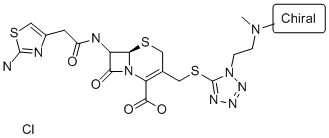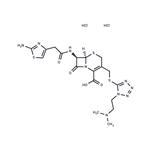Description
Cefotiam was synthesized by Takeda Chemicals Industries in 1977 as the first cephem derivative to introduce the aminothiazol group in the 7 side chain and the alkylated tetrazole group at the 3 side chain . This drug shows greater antibacterial activity against gram-negative bacteria than the earlier cephalosporins, including Enterobacter, Citrobacter, and indole-positive Proteus, and it retains the same activity as they have against gram-positive organisms. Its excellent activity against Klebsiella and Escherichia coli is based on its ability to penetrate the cell. This is 3- to 70-fold greater than that of cephalothin or cefazolin.
Uses
Cefotiam hydrochloride (SCE-963 hydrochloride) is a parenteral cephalosporin antibiotic. Cefotiam has broad-spectrum activity against Gram-positive and Gram-negative bacteria.
Definition
ChEBI: Cefotiam dihydrochloride is the dihydrochloride salt of cefotiam. It has a role as an antibacterial drug. It contains a cefotiam.
brand name
Ceradon (Takeda).
Pharmacokinetics
Cefotiam Hydrochloride is the hydrochloride salt form of cefotiam, a third-generation, semi-synthetic, beta-lactam cephalosporin antibiotic with antibacterial activity. Cefotiam binds to penicillin-binding proteins (PBPs), transpeptidases that are responsible for crosslinking of peptidoglycan. By preventing crosslinking of peptidoglycan, cell wall integrity is lost and cell wall synthesis is halted.




